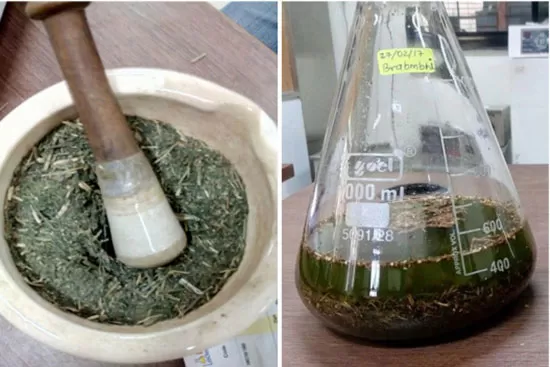- 0086-571-85302990
- sales@greenskybio.com
Saponins Unleashed: The Science Behind Tribulus Terrestris 45 Extract
2024-08-17
Introduction
Tribulus terrestris has long been a subject of interest in the field of natural health supplements. Tribulus Terrestris 45 extract in particular stands out for its potential health benefits. Central to these benefits are the saponins present in the extract. Saponins are a diverse group of natural compounds that are found in a variety of plants, and in Tribulus terrestris, they play a crucial role. This article aims to provide a comprehensive exploration of the scientific aspects related to Tribulus Terrestris 45 extract and its saponins.
The Chemistry of Saponins in Tribulus Terrestris 45 Extract
Saponins are glycosides with a characteristic structure. In Tribulus terrestris 45 extract, they are composed of a steroid or triterpenoid aglycone linked to one or more sugar moieties. This unique chemical structure is what gives saponins their diverse biological activities. The saponins in Tribulus terrestris can be classified into different types based on their aglycone structure, such as steroidal saponins. These chemical properties are important as they determine how the saponins will interact with the body's biological systems.
Interaction with Cells and Receptors
Cell Membrane Interaction
One of the key ways in which saponins in Tribulus Terrestris 45 extract interact with the body is through the cell membrane. Saponins have the ability to interact with the lipid bilayer of the cell membrane. They can insert themselves into the membrane, causing changes in its fluidity and permeability. This interaction can have a range of effects on the cell. For example, it can influence the uptake of nutrients or the release of signaling molecules from the cell.
Receptor Binding
Saponins also interact with specific receptors on the cell surface. These receptors play a role in various physiological processes. In the case of Tribulus terrestris, some of the saponins may bind to receptors involved in hormonal regulation. For instance, they may interact with androgen receptors in male cells or estrogen receptors in female cells. This receptor binding can trigger a cascade of intracellular signaling events, leading to changes in gene expression and ultimately, physiological responses.
Impact on Male Reproductive Health
There is growing evidence suggesting that Tribulus Terrestris 45 extract and its saponins may have a positive impact on male reproductive health.
- Testosterone Levels: Some studies indicate that the saponins in Tribulus terrestris may have an effect on testosterone production. Testosterone is a key male sex hormone involved in various aspects of male reproductive function, including sperm production and libido. The saponins may stimulate the Leydig cells in the testes, which are responsible for testosterone synthesis.
- Sperm Quality: Another area of interest is the potential improvement in sperm quality. Saponins may enhance sperm motility and viability. This could be due to their effects on the cells involved in sperm development and maturation, such as Sertoli cells. By interacting with these cells, saponins may provide a more favorable environment for sperm production.
Impact on Female Reproductive Health
Tribulus Terrestris 45 extract and its saponins are not only relevant to male reproductive health but also show potential benefits for female reproductive health.
- Hormonal Balance: In females, hormonal balance is crucial for normal reproductive function. The saponins in Tribulus terrestris may interact with estrogen receptors, potentially helping to regulate estrogen levels. This could have implications for menstrual regularity and fertility.
- Ovarian Function: There is some evidence to suggest that Tribulus terrestris may support ovarian function. It may help in the development and maturation of ovarian follicles, which are essential for ovulation and subsequent pregnancy.
Extraction Methods of Tribulus Terrestris 45 Extract
The extraction method used to obtain Tribulus Terrestris 45 extract plays a significant role in determining the quality and potency of the saponins present.
Solvent Extraction
One common method is solvent extraction. Different solvents can be used, such as ethanol or methanol. Solvent extraction has the advantage of being able to extract a wide range of saponins. However, the choice of solvent can also influence the purity of the extract. For example, if the solvent is not properly removed, it may leave residues in the extract, which could affect its safety and quality.
Supercritical Fluid Extraction
Supercritical fluid extraction, particularly using carbon dioxide, is another method. This method has several benefits. It can produce a more pure extract as it allows for better separation of the saponins from other components in the plant. Also, since carbon dioxide is a non - toxic and environmentally friendly solvent, it is a more sustainable option. However, this method requires more complex equipment and is generally more expensive.
Quality Control and Standardization
Ensuring the quality and standardization of Tribulus Terrestris 45 extract is crucial for its safe and effective use.
- Analysis of Saponin Content: One of the key aspects of quality control is the accurate determination of saponin content. This can be done using various analytical techniques, such as high - performance liquid chromatography (HPLC). By measuring the saponin content, manufacturers can ensure that their products contain the appropriate amount of active compounds.
- Purity and Contaminant Testing: It is also important to test for purity and contaminants. Purity testing ensures that the extract is free from other unwanted substances, such as heavy metals or pesticides. Contaminant testing helps to identify any potential harmful substances that may be present in the extract.
Conclusion
In conclusion, Tribulus Terrestris 45 extract and its saponins are a fascinating area of study. The scientific research behind their interaction with cells and receptors, as well as their potential impact on male and female reproductive health, is still in progress. The extraction methods used to obtain the extract are also an important consideration, as they can affect the quality and potency of the saponins. Quality control and standardization are essential to ensure the safety and effectiveness of products containing Tribulus Terrestris 45 extract. As research continues, we can expect to gain a more in - depth understanding of this natural extract and its potential applications in promoting health.
FAQ:
What are the main functions of saponins in Tribulus Terrestris 45 extract?
The saponins in Tribulus Terrestris 45 extract have several potential functions. They can interact with the body's cells and receptors. In terms of reproductive health, they may have an impact on both male and female. However, more research is still needed to fully understand all of their functions.
How do the saponins in Tribulus Terrestris 45 extract interact with the body's cells?
The saponins interact with the body's cells through various mechanisms. They may bind to specific receptors on the cell surface, which can then trigger a series of intracellular signaling pathways. This interaction can influence cell function, such as metabolism, growth, and differentiation. But the exact nature of these interactions is still being studied.
What is the significance of Tribulus Terrestris 45 extract for male reproductive health?
Tribulus Terrestris 45 extract may play a role in male reproductive health. The saponins it contains could potentially affect hormone levels, sperm production, or sexual function. Some studies suggest that it might enhance testosterone levels, which could have positive effects on libido and fertility. However, the evidence is not conclusive yet.
How do different extraction methods influence the quality and potency of saponins in Tribulus Terrestris 45 extract?
Different extraction methods can have a significant impact on the quality and potency of saponins in Tribulus Terrestris 45 extract. For example, some extraction methods may be more efficient at isolating the saponins, while others may cause degradation or loss of certain active components. The choice of solvent, temperature, and extraction time are all factors that can affect the final product. High - quality extraction methods are crucial for obtaining a potent and effective extract.
Is Tribulus Terrestris 45 extract safe for consumption?
While Tribulus Terrestris 45 extract is generally considered safe for most people when used appropriately, there can be potential side effects. Some individuals may experience mild gastrointestinal discomfort, such as nausea or diarrhea. Also, it may interact with certain medications. It is always advisable to consult a healthcare professional before starting to use any new supplement.
Related literature
- The Bioactivity of Saponins in Tribulus Terrestris: A Review"
- "Tribulus Terrestris Extract: Extraction Techniques and Biological Properties"
- "Saponins and Reproductive Health: Insights from Tribulus Terrestris"
- ▶ Hesperidin
- ▶ citrus bioflavonoids
- ▶ plant extract
- ▶ lycopene
- ▶ Diosmin
- ▶ Grape seed extract
- ▶ Sea buckthorn Juice Powder
- ▶ Beetroot powder
- ▶ Hops Extract
- ▶ Artichoke Extract
- ▶ Reishi mushroom extract
- ▶ Astaxanthin
- ▶ Green Tea Extract
- ▶ Curcumin Extract
- ▶ Horse Chestnut Extract
- ▶ Other Problems
- ▶ Boswellia Serrata Extract
- ▶ Resveratrol Extract
- ▶ Marigold Extract
- ▶ Grape Leaf Extract
- ▶ blog3
- ▶ blog4
- ▶ blog5
-
What are extracts made of?
2024-08-17
-
Extract Usage: A Comprehensive Guide
2024-08-17
-
Are plant extracts good for you?
2024-08-17
-
What are plant-based extracts?
2024-08-17
-
What Is a Plant Extract? A Deep Dive
2024-08-17
-
American Ginseng Root Extract
2024-08-17
-
Calendula Extract
2024-08-17
-
Oyster Mushroom Extract Powder
2024-08-17
-
Artichoke Leaf Extract
2024-08-17
-
Eucommia Ulmoides Extract
2024-08-17
-
Berberis aristata Extract
2024-08-17
-
Polygonum multiflorum extract
2024-08-17
-
Clove Powder
2024-08-17
-
Hedyotis Diffusa Extract
2024-08-17
-
Hesperidin
2024-08-17































